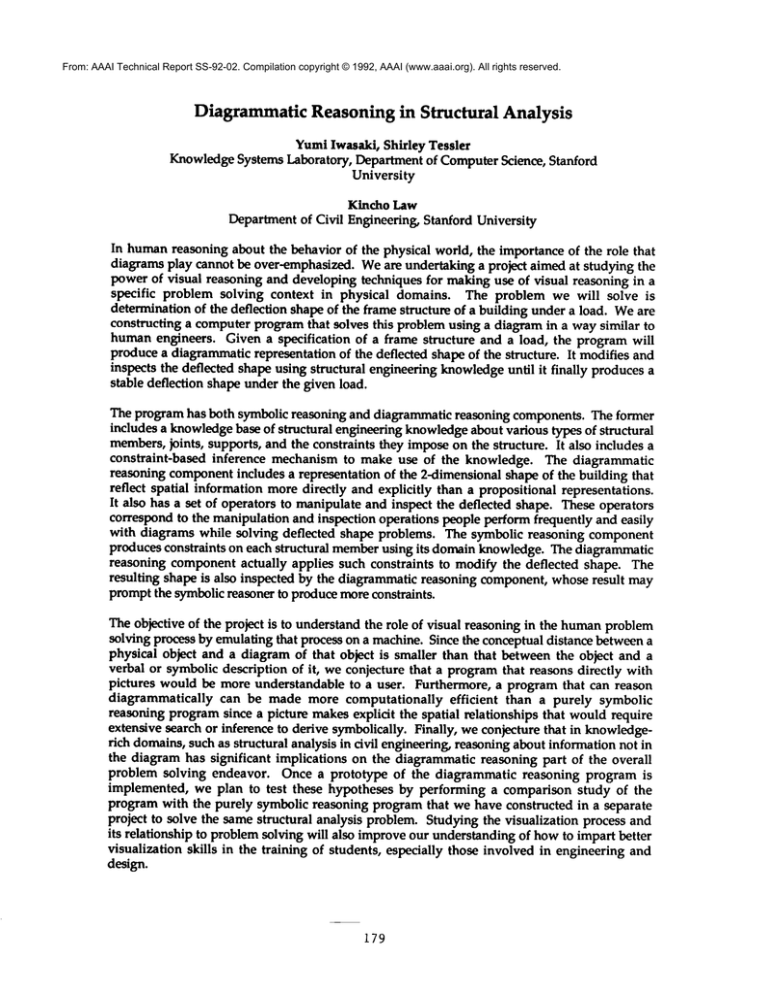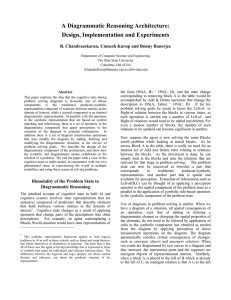
From: AAAI Technical Report SS-92-02. Compilation copyright © 1992, AAAI (www.aaai.org). All rights reserved.
Diagrammatic Reasoning in Structural Analysis
YumiIwasald, Shirley Tessler
KnowledgeSystems Laboratory, Department of ComputerScience, Stanford
University
Kincho Law
Departmentof Civil Engineering, Stanford University
In humanreasoning about the behavior of the physical world, the importance of the role that
diagrams play cannot be over-emphasized. Weare undertaking a project aimed at studying the
power of visual reasoning and developing techniques for making use of visual reasoning in a
specific problem solving context in physical domains. The problem we will solve is
determination of the deflection shape of the frame structure of a building under a load. Weare
constructing a computer programthat solves this problem using a diagram in a way similar to
humanengineers. Given a specification of a frame structure and a load, the program will
produce a diagrammaticrepresentation of the deflected shape of the structure. It modifies and
inspects the deflected shape using structural engineering knowledgeuntil it finally produces a
stable deflection shape under the given load.
The program has both symbolic reasoning and diagrammatic reasoning components. The former
includes a knowledgebase of structural engineering knowledgeabout various types of structural
members,joints, supports, and the constraints they imposeon the structure. It also includes a
constraint-based
inference mechanism to make use of the knowledge. The diagrammatic
reasoning componentincludes a representation of the 2-dimensional shape of the building that
reflect spatial information more directly and explicitly than a propositional representations.
It also has a set of operators to manipulate and inspect the deflected shape. These operators
correspond to the manipulation and inspection operations people perform frequently and easily
with diagrams while solving deflected shape problems. The symbolic reasoning component
produces constraints on each structural memberusing its domain knowledge. The diagrammatic
reasoning componentactually applies such constraints to modify the deflected shape. The
resulting shape is also inspected by the diagrammatic reasoning component, whoseresult may
promptthe symbolic reasoner to produce moreconstraints.
The objective of the project is to understand the role of visual reasoning in the humanproblem
solving process by emulating that process on a machine. Since the conceptual distance between a
physical object and a diagram of that object is smaller than that between the object and a
verbal or symbolic description of it, we conjecture that a programthat reasons directly with
pictures would be more understandable to a user. Furthermore, a program that can reason
diagrammatically can be made more computationally efficient than a purely symbolic
reasoning program since a picture makesexplicit the spatial relationships that would require
extensive search or inference to derive symbolically. Finally, we conjecture that in knowledgerich domains,such as structural analysis in civil engineering, reasoning about information not in
the diagram has significant implications on the diagrammatic reasoning part of the overall
problem solving endeavor. Once a prototype of the diagrammatic reasoning program is
implemented, we plan to test these hypotheses by performing a comparison study of the
program with the purely symbolic reasoning program that we have constructed in a separate
project to solve the same structural analysis problem. Studying the visualization process and
its relationship to problem solving will also improve our understanding of howto impart better
visualization skills in the training of students, especially those involved in engineering and
design.
179





